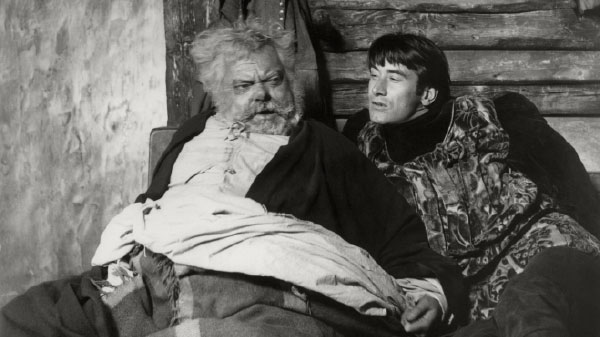
Making Chimes at Midnight
Like so many of Orson Welles’s films after his initial Hollywood studio productions of the 1940s, the first decade of his movie career, Chimes at Midnight was independently financed. Shot between September 1964 and April 1965, it received Swiss and Spanish funding and was filmed in several locations in Spain: Ávila, Cardona, and Madrid. To secure financing, Welles had to convince his producer that he would also direct an adaptation of Treasure Island, a film Welles never intended to make. The producer also wanted Chimes at Midnight to be shot in color, but Welles, a staunch believer in the expressive cinematic power of black and white, disagreed. (Welles also thought that no color film had ever successfully captured a human face without makeup, rendering a gritty period piece, in his eyes, impossible.) Nevertheless, the production was so low-budget that the producers couldn’t raise the money for color film stock anyway. Lack of funds also affected the film’s audio, much of which had to be dubbed in postproduction. And financial troubles persisted: the production ran out of money in December of 1964 and had to take a break from shooting, while additional funds were raised, until the end of February.
Faced with such constant budgetary concerns, Welles had to rely on his legendary cinematic ingenuity to make Chimes at Midnight into the spectacle it became. Welles himself planned and designed the set for the tavern, a central location in the film, which was built in a reconstructed warehouse, and the scenes set in the king’s court were filmed in a Spanish Gothic cathedral in the mountainous town of Cardona. But the film’s most unforgettable sequence, and one of the artistic high points of Welles’s entire career, is the Battle of Shrewsbury, during which Hal and Falstaff suit up to defend the king against a rebel army led by Harry Percy, or “Hotspur” (played by Norman Rodway). Shooting in the Casa de Campo park in Madrid, Welles constructed a massive battle scene of remarkable brutality and rawness, comprised of more than two hundred shots. Though inspired by Sergei Eisenstein’s Battle on the Ice in Alexander Nevsky (1938) and Laurence Olivier’s Battle of Agincourt in Henry V (1944), Welles’s scene is its own beast, an intentionally unheroic spectacle full of violent hand-to-hand combat and the sounds of screaming, swords clanging, and bones cracking. Welles utilized a variety of techniques to convey the madness of war, including a mix of handheld and tripod camera shots, slow motion and fast motion, swish pans and quick cuts. There is no patriotism or moral courage depicted in this scene, a reflection of the skepticism toward war that marked the decade in which the film was made—in contrast to Olivier’s Henry V, made during World War II, which was intended as an inspiration to British soldiers fighting the Nazis.
Ever the perfectionist, Welles worked on the film obsessively in postproduction, cutting and recutting it over the course of many months. The director of the Cannes Film Festival saw a rough cut and liked it so much that he pressured Welles into finishing the film in time for the 1966 festival; thus Welles ended up showing it before he felt it was really finished. Nevertheless, the response was largely positive, despite many viewers’ concerns about the sound quality. A negative advance review by the New York Times’ notorious Bosley Crowther, however, doomed its distribution in the United States, where it barely played. The film was not widely shown in theaters in the coming decades and was a casualty of rights disputes in the home video era, with different producers claiming ownership, and it received no official studio VHS or DVD releases. Thus, Chimes at Midnight has historically been difficult to see, which has only made it more precious. The film is now widely considered to be one of Welles’s finest achievements. The influential film scholar Dudley Andrew has called it “perhaps the greatest adaptation of Shakespeare that the cinema has yet produced.”
